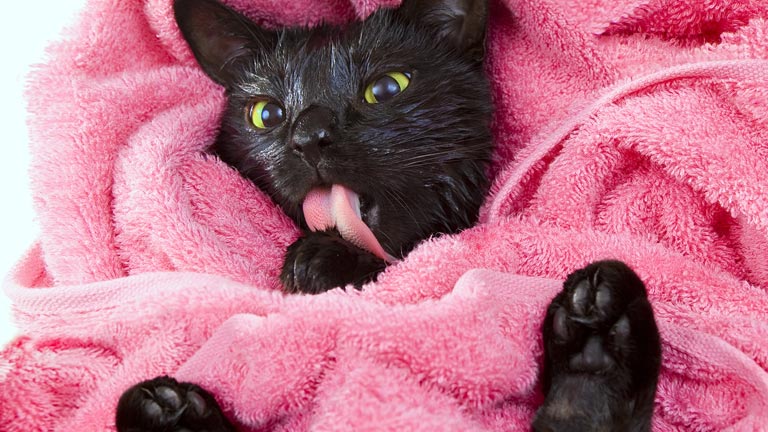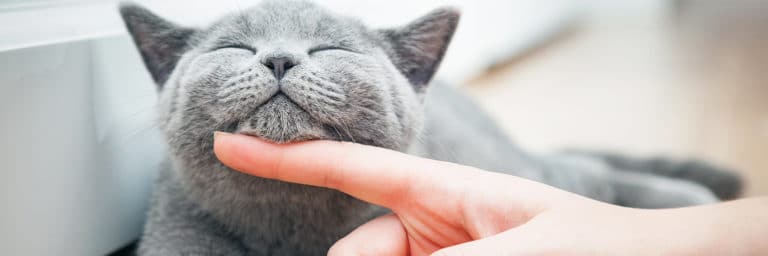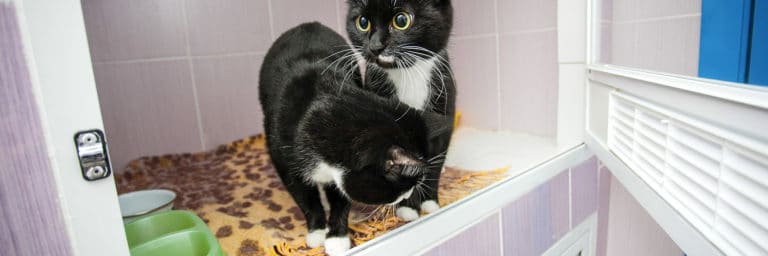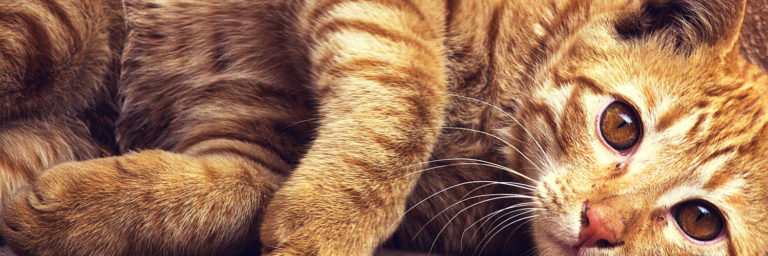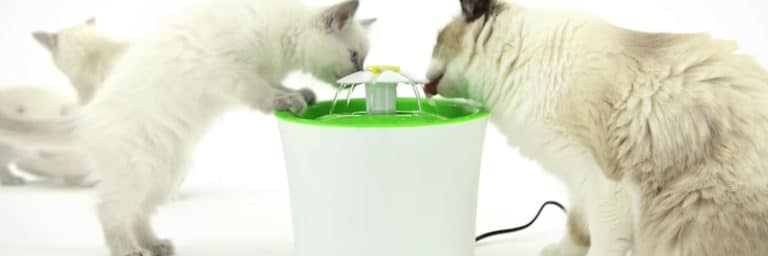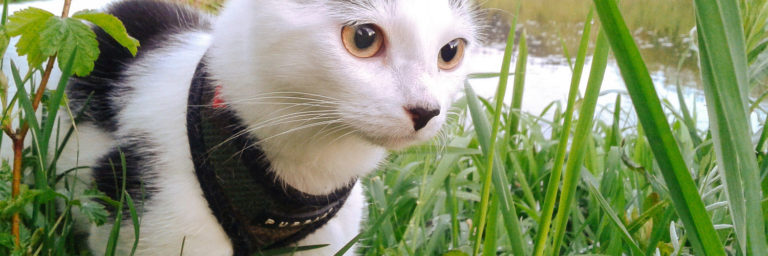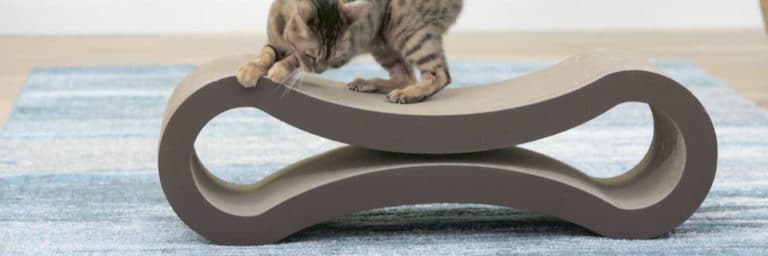The Best Cat Shampoos & Conditioners : Plus Helpful Tips for Bathing Your Cat
Contents of Article
Giving your cat a bath might already be a difficult task for you, but choosing a shampoo and conditioner that is safe but also effective can make it even more difficult.
There are many different types, used for different things, in a wide range of price points. It can tough to narrow them down and choose something that will work for your cat. We have researched cat shampoos and conditioners on the market to help narrow down the numerous choices to just a few that we think are great. Using these shampoos and conditioners can make bath time both enjoyable and effective for your cat.
The best cat shampoo is free from irritating ingredients, nourishes your cat’s coat, and helps to make bath time just a little bit less stressful. In this article, you’ll learn about the different types of cat shampoo on the market and how to choose the best product for your cat.
What are the Best Cat Shampoos & Conditioners?
Types of Cat Shampoos and Conditioners
The cat shampoo market includes three primary types of cleansers—traditional wet shampoo, shampoo and conditioner blends, and waterless or dry shampoos.
Traditional Cat Shampoo
These are gentle, mild solutions designed for self-grooming, delicate animals.
Cat Shampoo and Conditioner Blends
Conditioners coat the hair shaft, giving it a shiny look. Most cats don’t need conditioners, since felines are naturally greasy and have enough oils in their coat to maintain a shiny coat. Rough, unkempt, dandruff-laden coats may seem to demand conditioner, but they’re not typically the result of dry skin. Instead, these coats just need a little tender loving care from a brush, healthy diet, and standard shampoo.
Conditioner isn’t necessary for most cats. Exceptions to this rule are cats with genuinely dry coats due to over-bathing or show cats who need a little extra shine for an upcoming competition.
Waterless Shampoo
If you and your cat hate baths, a waterless shampoo may be a good alternative to wet products. These come in powders, sprays, and wipes. All are good options, but it’s important to make sure that your choice is free from essential oils, which could harm your cat.
Here’s how to pick the best cat shampoo.
Choose a formula made with gentle, cat-friendly ingredients.
Cats have thin, delicate skin and they groom themselves—two reasons why they need an ultra-gentle shampoo specifically formulated for cats. Cats shouldn’t use human shampoo, dog shampoo, or any other product that’s not made for self-grooming animals. The best cat shampoo is made with simple ingredients, vegetable-based cleansers, and is free from irritating additives.
Avoid ingredients that could irritate your cat.
Fragrances
Fragrances can make your cat a sweet-smelling little fuzzbun after their bath, but they can also irritate your cat’s skin. Besides that, your cat has a very keen sense of smell, so it’s not very nice to overwhelm them with a soaking of vanilla almond or cherry blossoms.
While fragrances usually won’t hurt your cat, it’s a good idea to opt for unscented shampoo whenever possible.
Sulfates
Sulfates are used to create lather, which helps you to see where the shampoo is and can help you to feel like you’re doing something. They’re not necessarily harmful, but there may be a precedent for avoiding them. Sulfates are derived from a variety of sources, including petroleum and palm oil, and the making of both may have a negative environmental impact.
Parabens
Parabens are a group of preservatives added to many health and beauty products, including some cat shampoo.
While there’s no conclusive evidence that parabens are dangerous, studies have shown that they may disrupt hormone production, specifically mimicking estrogen in the body. These synthetic compounds go by several names, including butylparaben, methylparaben, propylparaben, and alkyl parahydroxybenzoates.
Dyes
Artificial colors may irritate your cat’s delicate skin, so it’s best to avoid them whenever possible.
Essential Oils
Cats can’t properly filter out the toxins in essential oils, so these ingredients can cause organ damage. Despite their danger to cats, essential oils are common in “natural products”. Read the label closely to ensure that the shampoo doesn’t contain any risky oils.
Is it safe to wash a cat with Dawn dish soap?
Smart marketing, tradition, and a balance of tenderness and toughness have made Dawn the staple dish soap for cleaning dirty critters of every kind.
If it’s safe enough to clean pelicans and sea turtles after an oil spill, it’s safe enough for your cat, right?
Yes. Dawn dish soap is safe for washing your cat.
People have been cleaning their cats and kittens with Dawn for decades and there’s no indication that anyone’s ever been harmed by it. That doesn’t mean it’s perfect.
Dish soap is designed to strip fats, which is what makes it so effective when cleaning grease-covered wildlife. It will also remove the natural oils from your cat’s skin, leading to flakiness and itching.
If you do use dish soap on your cat, opt for an unscented variety with as few additives as possible. Original Dawn is the preferred variety, but you could get away with other clear, mild dish soaps.
Is human shampoo safe for cats?
Compared to humans, cats have thin, delicate, and less acidic skin. Because their skin is so delicate, it’s important to treat them with only the gentlest products—and in most cases, you won’t find those in a bottle in the hair care department.
In addition to different skin, people don’t usually lick themselves after a bath. Cats do. They’ll ingest any residue remaining in their hair and on their skin. Human shampoo is usually made with toxic ingredients that could make your cat sick if ingested.
There is one exception to the “no human shampoo” rule. Most tearless baby shampoo is extremely gentle and safe for cats. Just remember to use a small amount and, as always, rinse your cat thoroughly after washing.
The Best Cat Shampoo on the Market
Best Overall: Earthbath Hypo-Allergenic Totally Natural Pet Shampoo
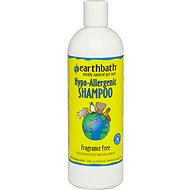
Earthbath is one of the most well-regarded brands in pet shampoo. Their vast selection of dog and cat shampoos includes products in a wide range of scents and specific purposes.
This Earthbath shampoo earns the first place spot with its fragrance-free formula made without any potential irritants like parabens, dyes, and other synthetics. The formula includes purified water, extra-mild renewable coconut-based cleansers, aloe vera, xanthan gum, and olive oil squalene, which is a preservative.
All of these ingredients are gentle on your cat’s skin and, according to customer reviews, are powerful cleansers perfect for dirty coats of every variety.
Pros
- One of the leading pet shampoos
- Made without irritating ingredients
- Safe, soothing, and gentle
Cons
- Some reviewers said it didn’t help their cat’s itchy skin
Runner Up: Earthbath Oatmeal & Aloe Dog & Cat Shampoo
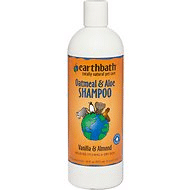
Like our number one choice, this is an Earthbath product.
While our number one pick was an unscented shampoo, this one has a vanilla and almond fragrance. The scent comes from food-grade extracts of vanilla and almond—yes, the same things you might mix into a birthday cake. You don’t have to worry about them irritating your cat.
The shampoo is made from water, colloidal oatmeal, “renewable plant-derived 6 coconut-based cleansers”, organic aloe vera, vitamins A, B, D, & E, glycerin, allantoin, vanilla and almond extract, and “natural preservative”.
The shampoo is available in a 16-oz or 1-gallon bottle.
Pros
- Gentle and safe for cats
- Contains gentle, nourishing ingredients
- Has a reputation for excellence
- Naturally scented with vanilla and almond extracts
- Free from irritants
Cons
- Cats may not like the scent
Best Cat Shampoo for Kittens: Burt’s Bees Kitten Shampoo
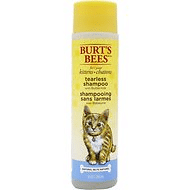
While kittens can really use most non-medicated adult shampoos, you may choose to opt for a kitten formula instead. This one from Burt’s Bees is infused with creamy-dreamy additives like honey and buttermilk powder. It’s made from 99.7% natural ingredients and doesn’t contain any additives that might irritate your kitten’s skin.
This shampoo formula is made from water, coco glucoside, glyceral oleate, coco betaine, glycerin, xanthan gum, honey, beeswax, buttermilk powder, citric acid, potassium sorbate, and phenoxyethanol.
The shampoo comes in a 10 oz bottle.
Pros
- Has an appealingly creamy, buttery smell and look
- Customers say it cleans well and rinses easily
- Free from irritating ingredients
- Naturally scented
Cons
- Only available in small bottles
Best Waterless/Dry Shampoo: Burt’s Bees Waterless Shampoo for Cats
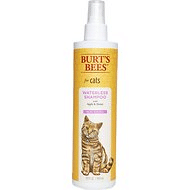
If your cat is only mildly dirty and both of you hate traditional baths, a waterless shampoo might be an effective alternative cleaning tool. A dry shampoo isn’t enough for greasy, filthy cats, but it can spruce up your cat if they’ve been getting behind on their grooming.
This product from Burt’s Bees is free from the essential oils typical in other dry shampoos and doesn’t contain anything else that could harm your cat. It’s a 99.8% natural product made from water, disodium cocoyl glutamate, coco betaine, glycerin, honey, pyrus malus (apple) fruit extract, citric acid, potassium sorbate, and phenoxyethanol.
Customer reviews suggest that the dry shampoo works well for minor cleanups, although a few users say that the spray bottle frightened their cats. One described it as “basically sticky water”, saying that it left their cat sticky and not a bit cleaner.
Pros
- Allows you to clean your cat without the fuss of a watery bath
- Gently conditions the skin
- Effectively cleans the coat
Cons
- Not appropriate for seriously dirty cats
Homemade Shampoo – Making Your Own Cat Shampoo
If you can’t get cat shampoo right now, consider making your own homemade cat shampoo. Here are a couple of recipes to help you get started.
Homemade Dry Cat Shampoo Recipe
Ingredients
- ⅓ cup cornmeal
- ⅓ cup rolled oats
- ⅓ cup unprocessed bran
Instructions
Combine all the ingredients in a microwave-safe container, microwave for 10 seconds, then let it cool off. Once the mixture has reached room temperature, gently rub it through your cat’s fur. Once you’ve rubbed it deep into your cat’s coat, use a comb or brush to remove the mixture from your cat’s fur.
Adapted from Catappy’s dry cat shampoo recipe.
Homemade Wet Cat Shampoo Recipe
- 1 3/4 cups water
- 1/4 cup grated castile bar soap
- 1/4 cup and 2 tablespoons liquid castile soap
- 2 tsp baking soda
- 1 tsp vegetable glycerin
In a small to medium-sized saucepan, combine the water and grated bar soap, then bring the mixture to a boil. While the bar soap and water is bubbling on the stove, combine the liquid soap, baking soda, and vegetable glycerin in a separate container.
Mix and heat until the bar soap has been completely combined with the water, then add the hot mixture to your soap blend. Mix well.
After your soap has cooled completely, use it as you would any dish soap for shampooing your cat.
Adapted from Meowcat’s DIY homemade dish soap recipe.
Helpful Tips for Bathing Your Cat
Before the first drop of shampoo touches your cat’s skin, you should have a solid strategy in mind. Setting up your bathing area and acquiring the appropriate tools will ensure that you and your cat both have a smooth experience.
First, prepare the bathing area.
Decide where you’ll wash your cat. While almost any location will work, the bathroom is an ideal area. A relatively small space and a closing door are advantages for anyone wrangling a wet cat.
Line the tub with a towel or a rubber mat for your cat to hold onto. You might consider placing a window screen or fine wire mesh in the bathtub. It will give your cat something to hold onto and keeps their claws occupied, reducing your chances of getting scratched.
Prepare your cat for bathtime.
Your cat doesn’t have to undress for his bath, but he should have a nice nail clipping and hair brushing before he gets into the tub. Clipping your cat’s nails will reduce his ability to scratch you when things get a little too damp, and brushing his fur will minimize the amount of hair that ends up in the drain. It may also remove any excess dirt, making your job a little bit easier.
Bring your cat into the bathroom and close the door behind you.
If possible, bring an assistant along. A wet cat can overpower a single human, so it’s nice to have someone to help restrain the cat while you do the washing.
If the water is deep enough for your cat to swim in, you’re probably doing it wrong.
Here’s a tip that just might turn your cat from a bath-hater to a bath-lover—don’t fill up the bath. Not even an inch. Unless your cat is a pro kitty-paddler who loves the water, there’s no need to drop them into a pool.
Instead, leave the bathtub dry and plop your cat down on the rubber mat, towel, or wire screen you prepared earlier. With no scary water on their paws and something to hold onto, your cat will feel much more at ease.
Splash or spray.
If you have a sprayer—great! You can use the water sprayer on a gentle setting to douse your cat with warm water. Otherwise, fill a cup with water and gently pour it over your cat’s body, being careful not to pour any in their eyes, nose, or ears. If you’re using a sprayer, keep the nozzle close to your cat’s body. This will minimize the sound and help to keep your cat calm.
Lather up!
Once you’ve dampened your cat, use the shampoo as directed. Once you’ve massaged it into your cat’s skin and coat, rinse him thoroughly. It’s important to remove all shampoo residue to ensure that your cat doesn’t ingest any of it when he grooms afterwards.
Once your cat is washed and rinsed, it’s time to dry off.
Remove your cat from the bathtub or washbasin. Towel-dry them as much as you can or, if they don’t protest, gently blow-dry them. If you’re unable to fully dry them off on your own, give them a comfortable place to sit in front of the bathroom heater. Let your cat stay there until they’re dry. If you unleash them on the house, they might end up dirtier than they were before. Damp cats love to walk through their litter box and make little clay cakes on their wet paws.
While your cat is drying, give them a treat or two. Good food can repair a bad mood and could help make your cat’s next bathing session a little more pleasant.
It’s not recommended that you bathe your cat more than once every few weeks. Excessive bathing could dry out your cat’s skin.

